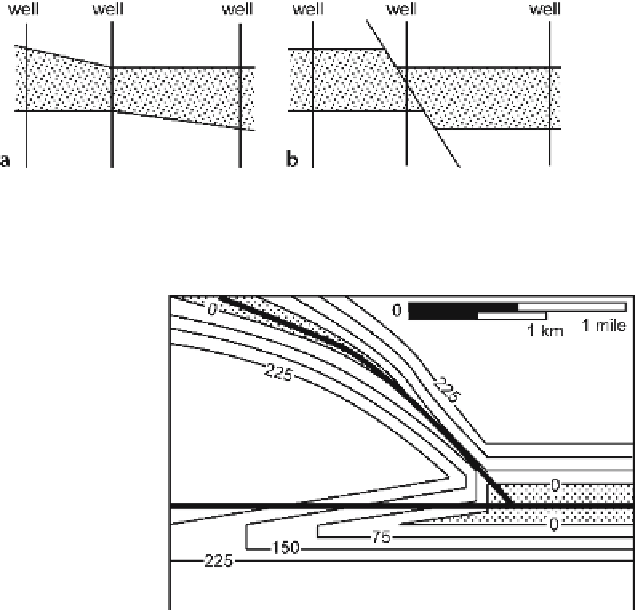Geology Reference
In-Depth Information
dence for faulting is desirable before the fold is reinterpreted as a fault as, for example,
a direct observation of the fault somewhere along the trend. In some areas, especially
in extensional terrains, folds with steep limb dips are rare or do not occur at all and
so the closely spaced contours could be replaced by a fault on the basis of consistency
with the local structural style.
7.2.4
Stratigraphic Thickness Anomaly
A linear thickness anomaly in a generally uniform stratigraphic unit may be caused by a
fault. The anomaly can be caused by the stratigraphic section missing or repeated by an
unrecognized fault. A fault appearing as a thickness anomaly is a very likely occurrence
where the stratigraphic separation on the fault is less than the stratigraphic resolution. A
unit penetrated by three wells (Fig. 7.7a) might be interpreted as having a stratigraphic
thin spot in the middle well. The thin spot might also represent a normal fault cut (Fig. 7.7b).
Where a thickness anomaly is recognized as a possible fault, the data should be re-exam-
ined for other types of evidence of a fault cut. A cross section involving multiple units,
rather than just one unit as in Fig. 7.7, should be constructed. Thickness anomalies that
line up on a cross section with a dip appropriate for a fault probably represents a fault.
Fig. 7.7.
Cross sections showing alternative interpretations of a stratigraphic thickness anomaly in the
shaded
unit of the center well.
a
Thinning interpreted as due to stratigraphic change.
b
Thinning in-
terpreted as due to a normal fault
Fig. 7.8.
Isopach map showing the ef-
fect of two intersecting nor-
mal faults on the thickness of
a formation that is regionally
225 or more units thick. Con-
tours are of thickness, the
formation is
absent
in the
shaded areas
.
Heavy lines
mark
the fault trends; because the
faults are dipping planes, the
lines do not represent the ex-
act map traces of the faults

